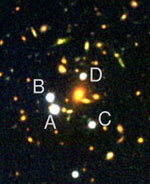Scientists from the Sloan Digital Sky Survey (SDSS) have discovered a quasar inside the best-resolved gravitational lens ever recorded. Also, contrary to predictions, they discovered that four of the most distant and brightest known quasars are not inside a gravitational lens.
Translation: Dikla Oren

Scientists from the Sloan Digital Sky Survey (SDSS) have discovered a quasar inside the best-resolved gravitational lens ever recorded. Also, contrary to predictions, they discovered that four of the most distant and brightest known quasars are not inside a gravitational lens.
Albert Einstein's general theory of relativity predicts that the gravitational pull of a massive body can act as a lens, causing the light from a distant object to bend and warp. A massive structure somewhere between Earth and a distant quasar could act as a lens, making the image much brighter and producing several copies of the quasar.
In an article published in the December 18/25 edition of the journal Nature, a team from SDSS led by Naohisa Inda and Masmon Uguri, graduates of the University of Tokyo, reported that four nearby quasars are, in fact, light from one quasar, split into four images by gravitational lensing.
More than 80 gravitationally lensed quasars have been discovered since the first example was found in 1979. A dozen of these quasars were discovered by SDSS, and about half of them are the work of Inda and his team.
What makes the latest findings quite dramatic, is that the separation between the four images is twice as good as any previous cases of quasars in gravitational lenses. Until the discovery of this quartet of quasars, the largest separation of quasars in gravitational lenses was 7 arcseconds. The quasar, which the team from SDSS found resides in the constellation Leo Minor; It consists of four images, which are separated by 14.62 arcseconds.
To produce such a good separation, the density of the material, which causes the gravitational lens, must be extremely high. There is a cluster of galaxies at the front of this gravitational lens; The dark matter in this cluster is likely responsible for the unprecedented separation.
"Additional observations, produced by the 8.2 meter Subaru telescope and the Keck telescope, confirmed that this system is indeed evidence of gravity," explains Inda. "Contracts, that quasars are separated at such a level by gravitational lensing, are very rare, so they can only be discovered in large observatories like the SDSS."
Uguri added: "The discovery of one wide gravitational lens out of over 30,000 quasars observed by SDSS so far is completely consistent with the theoretical predictions of models of the universe, in which it is dominated by cold dark matter. This offers further strong evidence for these models.” (Cold dark matter, unlike hot dark matter, forms compact clusters of the kind that make such gravitational lenses.)
"The gravitational lens we discovered will provide the perfect laboratory to study the relationship between visible objects and invisible dark matter in the universe," Uguri explained.
In another paper, to be published in the March 2004 issue of the Astronomical Journal, a team led by Gordon Richards of Princeton University used the high resolution of the Hubble Space Telescope to examine the four most distant known quasars discovered by SDSS for signs of gravitational lensing.
Looking at great distances in astronomy is like looking back into the past. These quasars are visible at a time when the universe was less than ten percent of its current age. The quasars are unusually bright, and are thought to be powered by giant black holes, with several billion solar masses. The researchers said that it is a mystery how such massive black holes could have formed in the young universe. Conversely, if these objects are gravitationally lensed, the SDSS researchers will conclude that the quasars are less bright and the black holes have smaller masses, so it will be easier for them to explain their formation.
"The more distant a quasar, the more likely you will find a galaxy between it and the observer. Therefore, we expected that the most distant quasars would be found in gravitational lensing," explained SDSS researcher Xiaohui Pen from the University of Arizona. However, despite expectations, none of the four show signs of doubled images, which are the hallmark of gravitational lensing.
"Only a small fraction of quasars are in a gravitational lens, but such bright quasars are very rare in the distant universe. "Because gravitational lensing makes quasars appear brighter, and therefore easier to detect, we expected that the most distant quasars would be the most likely to be gravitationally lensed," said team member Zoltan Hayman of Columbia University.
"The fact that these quasars are not in a gravitational lens means that astronomers should take seriously the idea that quasars with several billion solar masses formed less than a billion years after the Big Bang," said Richards. "We are now looking for more examples of redshifted quasars in the SDSS to give theorists more massive black holes to explain."
